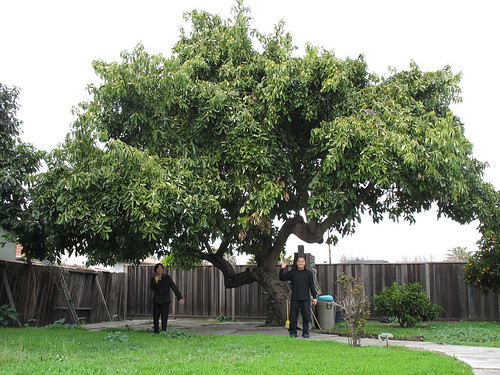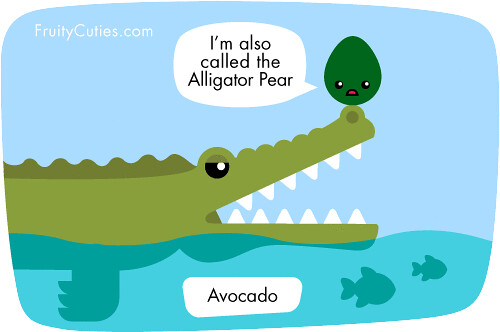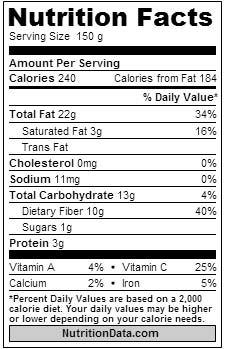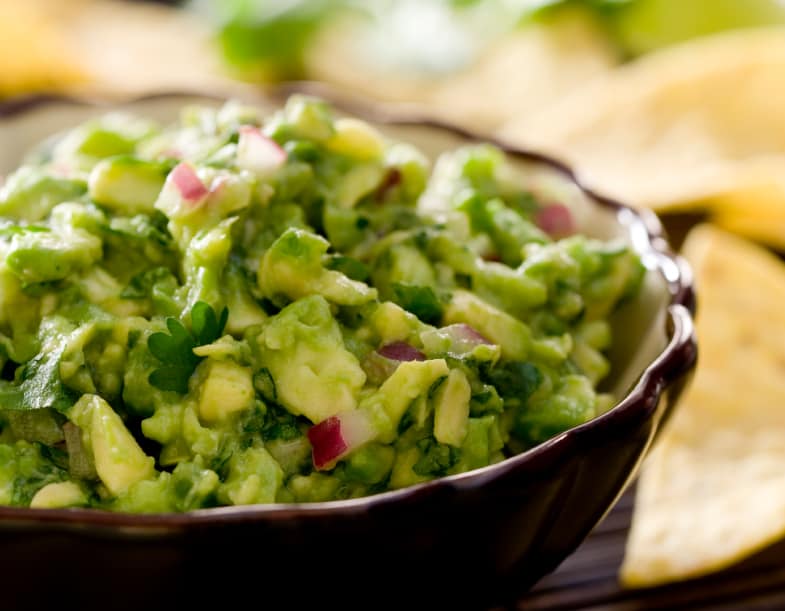A whole lotta people watched the Superbowl tonight. And a whole lotta those people ate guacamole. So I thought now would be a good time to talk about guacamole.

Guacamole served in one of those trendy, so-called authentic volcanic mortar bowls.
(Photo and recipe from the California Avocado Commission)

Avocados grow on trees, like this. A single tree can produce anywhere from 150 to 500 avocados in one year.
(Photo by joeysplanting, sourced from The Garden Lady, who can tell you how to grow an avocado tree)

This is how an avocado seedling sprouts from that giant pit inside.
(Photo from Reclaim Grow Sustain)

This is how avocados hang from the tree. Like a pair of testicles.
(Photo from AnandTech forums)

Or, maybe now, people think the name "alligator pear" is cute. And perhaps more appealing to children than "avocado."
(Image from FruityCuties on Flickr)

Nutrition Facts for 1 cup of raw avocados. More info available from NutritionData.com

This might be a better way of demonstrating how the fat in avocado really isn't so bad, compared to other fatty foods.
(Diagram from Smart Living)
The most nutritious part of the avocado is just beneath the skin, in the darker green flesh. So avocado growers recommend using the "nick and peel" method to take off the skin, which will help preserve the nutrient-est part of the fruit. That method is demonstrated here:

Guacamole. Once you start eating it, you can't stop.
(Recipe & photo by Quentin Bacon at Real Simple)

Left to right: Habanero, serrano, jalapeño. Hottest, hotter, hot
(Photo from cookthink.com)

Anjali at The Pickyeater makes her guacamole according to the recipe in a cookbook called Must Have Been Something I Ate (which I think is a terrible name for a cookbook). This recipe calls for extra spices, including cumin & coriander, the juice of both limes and lemons, and instead of fresh peppers, uses chili powder and cayenne.
(Photo and recipe at The Pickyeater)

The recipe for this guacamole won the California Avocado Commission's recipe for Best Guacamole Ever -- in 2010.
(Photo and recipe from the California Avocado Commission)
Hey, I almost forgot. This is my 700th Apple. It's late and I don't know what to say about that at the moment other than, 700 is a fairly big number.
Sources
Mother Nature Network, Who invented guacamole? June 19, 2013
Olga Khazan, The Selling of the Avocado, January 13, 2015
Online Etymology Dictionary, guacamole
Guyot, Top 10 Romantic Foods: Avocado
California Avocado Commission, Fun Avocado Facts
The World's Healthiest Foods, Avocados
Live Science, Avocados: Health Benefits, October 23, 2014
Gourmet Sleuth, Guacamole - Recipe Ingredients and History
Eat More Chiles, Serrano
Cookthink.com, Habanero vs. Serrano vs. Jalapeño

Guacamole served in one of those trendy, so-called authentic volcanic mortar bowls.
(Photo and recipe from the California Avocado Commission)
Avocados
- Guacamole, as I'm sure you know, is made from avocados. So let's start there.
- Avocados are native to Mexico. The Aztecs who lived in Mexico before it was colonized by Spain were cultivating avocado trees as long ago as 500 B.C. We have evidence that the Incas in Peru were cultivating avocados as far back as 750 B.C.
- The avocado trees were growing in Mexico, just on their avocado-own, as long ago as 5,000 to 7,000 B.C.

Avocados grow on trees, like this. A single tree can produce anywhere from 150 to 500 avocados in one year.
(Photo by joeysplanting, sourced from The Garden Lady, who can tell you how to grow an avocado tree)

This is how an avocado seedling sprouts from that giant pit inside.
(Photo from Reclaim Grow Sustain)

This is how avocados hang from the tree. Like a pair of testicles.
(Photo from AnandTech forums)
- The word "avocado" comes from the Nahuatl (the language spoken by the Aztecs) word "ahuacatl." Which means "testicles."
- So perhaps this is why the avocado is sometimes considered an aphrodisiac. (Something to consider this Valentine's Day.)
- Spanish priests arriving in Mexico did not find the joke funny at all. In fact, they took it so seriously, they prohibited their flock from eating the avocado.
- Maybe this is why it took 300 years for someone to bring avocados north from Mexico into California. The Spaniards arrived in Mexico in the 1500s; the first avocado trees weren't planted north of Mexico, in California, until 1871.
- Even then, it took a really long time for avocados to catch on with the American public in general. In the early 1900s, Americans were calling avocados "alligator pears" because of their shape and the way the skin is green and bumpy. Doesn't sound very appetizing, does it?

Or, maybe now, people think the name "alligator pear" is cute. And perhaps more appealing to children than "avocado."
(Image from FruityCuties on Flickr)
- It was the California Avocado Growers' Exchange who started calling them "avocados," deriving the word from the original Nahuatl in 1920.
- With lots of help from the California Avocado Growers' Exchange -- marketing and PR pieces and so on -- more people over the years began to get more familiar with the avocado. But the fruits were expensive to buy outside California, so they were considered something that rich people ate, or something that was served at fancy parties. Kind of like the way people talk about arugula now.
- Then, when prices were beginning to come down a bit and people were getting a little comfier with the avocado, the whole fat-is-bad thing hit in the 1980s and doctors started telling everybody "Don't Eat Fat." Since avocados have a lot of fat, especially for a fruit (yes, avocado is a fruit. And yes, 85% of its calories come from fat), people took this to mean that avocados are bad for you and will give you a heart attack or something terrible like that.
- It is true, avocados are relatively high in fat, but they've got the monounsaturated kind, the kind that may help chip away at your cholesterol. In addition, their particular kind of fats can also help to reduce inflammation, a benefit that people with arthritis have experienced. They also have 4 grams of protein per fruit. How many pieces of fruit can you think of that contain protein? So avocados and their fats are actually quite healthy-friendly.
- We've also learned since the 1980s that one cup of fresh avocado can increase your body's absorption of beneficial carotenoids & other antioxidants by anywhere from 200% to 400%. Let me put it this way: Spinach has all kinds of good stuff for your body. Put a little fresh avocado on that, and your body will extract even more goodness from that spinach.

Nutrition Facts for 1 cup of raw avocados. More info available from NutritionData.com

This might be a better way of demonstrating how the fat in avocado really isn't so bad, compared to other fatty foods.
(Diagram from Smart Living)
The most nutritious part of the avocado is just beneath the skin, in the darker green flesh. So avocado growers recommend using the "nick and peel" method to take off the skin, which will help preserve the nutrient-est part of the fruit. That method is demonstrated here:
- But we didn't know any of that in the 1980s. We just thought avocados were expensive and decadent and kind of bad for you.
- So in the 1990s, the California Avocado Growers started making commercials. There was one showing Angie Dickinson eating an avocado with a spoon, another one featuring an avocado named Mr. Ripe, whose purpose was to show people that ripe avocados are not bright green but rather a dark greenish-black. In other words, they were trying to promote the heck out of avocados.
- Then they found out that a lot of people were eating guacamole -- among other things -- on Super Bowl Sunday. Here, I have to pause for a minute and show you this quote from Olga Khazan, writing for The Atlantic:
Americans did with the big game what we’ve done with seemingly every national event: Turn it from a day centered on a specific purpose to a day of consuming thousands more calories than our stomachs will comfortably fit. Super Bowl Sunday became less about football fanaticism and more about chips and seven-layer dip. In recent years, Americans have consumed 1.23 billion chicken wings on Super Bowl Sunday and eaten 15 million pizzas.
- Pretty sharp, eh?
- Well, the Avocado Growers (now the California Avocado Commission) took advantage of this, big-time. In the days leading up to 1992's Super Bowl, they showed football players on TV eating guacamole. They got football players and their families to submit recipes for guacamole and had a tasting competition. At the game itself, they had PR people handing out samples of guacamole to fans at the stadium and to reporters. They did this sort of thing for a couple years running and pretty soon, guacamole and avocados became a companion story, along with the new of the game itself.
- And boy, did their efforts pay off. In 2012, we Americans ate 12 million pounds of avocados on Super Bowl Sunday. Yes, all those avocados on just one day.
- The only other days of the year when we eat as many or more avocados are on Cinco de Mayo -- a holiday we didn't pay much attention to as a country until recently -- and Independence Day. The avocado, a Mexican fruit once banned for its testicularity, has now become an American staple.
- Today, an estimated 43% of US households purchase avocados.
- That's a huge uptick from back in the 1960s, but it looks like there's more room to grow, doesn't it? Avocado growers in Mexico apparently agree because they're getting in on the marketing game, now too. I noticed -- and maybe you did too -- their commercial for avocados during this year's Super Bowl.
- 90% of the avocados we buy here in the U.S. come from California -- specifically from an area covering 52,000 acres from San Luis Obispo to San Diego. I guess the avocado growers in Mexico want to put a dent in that 90%.
Guacamole
- But we don't really care about marketing and commercials, do we? What we really care about is guacamole. Because it's gooooood.

Guacamole. Once you start eating it, you can't stop.
(Recipe & photo by Quentin Bacon at Real Simple)
- The Aztecs, who grew those avocados way back in the B.C. days, made guacamole too.
- If you'll remember, their word for avocados was ahuacatl (testicles, yes). Their word for guacamole was ahuaca-mulli, or avocado sauce or avocado mixture.
- I suppose, translated literally, that would be testicle sauce.
- Traditionally, guacamole is made from 5 ingredients:
- Avocado
- chiles or hot peppers
- onion
- tomato
- salt
- I know, you cilantro-lovers are saying, what about the lime and the cilantro? Most of us add those 2 ingredients today, but guacamole purists say that's not the truly traditional way to make guacamole. They say the lime & cilantro spoil the flavor. I know a few cilantro-lovers who might disagree with that.
- One other thing to note about these ingredients. I've always used jalapeño peppers because that's what's most readily available. But most of the recipes I've checked for this entry say to use serrano chile.
- Serranos look like jalapeños, but they are smaller and more slender. Like any pepper, they start out green when they are least ripe, and they slowly darken and get spicier through yellow to orange to red. The greener the pepper, the milder the heat.
- Serranos are hotter than jalapeños, but not as hot as cayenne or habanero peppers. One site describes the difference in heat levels this way: In a strong man contest, habaneros can lift an 18-wheeler, serranos a VW van, and jalapeños a Vespa scooter. So if you think spicy, you'd probably better not upgrade to serranos.

Left to right: Habanero, serrano, jalapeño. Hottest, hotter, hot
(Photo from cookthink.com)
- As with any truly good recipe, there are a million slightly different ways you can make it, according to your preferences. Same is true for guacamole.

Anjali at The Pickyeater makes her guacamole according to the recipe in a cookbook called Must Have Been Something I Ate (which I think is a terrible name for a cookbook). This recipe calls for extra spices, including cumin & coriander, the juice of both limes and lemons, and instead of fresh peppers, uses chili powder and cayenne.
(Photo and recipe at The Pickyeater)
- The Pixelated Crumb reproduces a recipe from Truly Mexican for pineapple and cucumber guacamole (which does include avocado).
- Dustin Maher, fitness trainer, uses his mother's recipe for guacamole which calls for garlic powder, dill, and sour cream.
- Green Prophet's recipe uses Israeli avocados, paprika, mayonnaise, lemon juice, and salsa.
- (By the way, adding your favorite salsa to a bowl of chopped or mashed avocado is the shortest short-cut to guacamole.)
- A news station in the Ozarks, KY3, has a recipe for guac that includes roasted poblano chiles, limes, garlic, and Louisiana hot sauce.
- If you want to make the traditional guac but also with cilantro & lime, Simply Recipes has your recipe.
- (I would show you photos of their guac, but these people have their copyright watermarks all over their pictures. So, no free photo PR from me.)
- If you really want to get wacky with it, Avocado Central has guacamole recipes like
- Bacon guacamole
- Buttermilk Ranch guacamole
- Mango guacamole
- Mariachi guacamole (does it really have ground-up mariachis in it?)
- Pistachio guacamole
- Tomatillo guacamole
- For a selection of more "authentic" or traditional recipes, check out the recipe options available at -- where else? -- the California Avocado Commission.

The recipe for this guacamole won the California Avocado Commission's recipe for Best Guacamole Ever -- in 2010.
(Photo and recipe from the California Avocado Commission)
Hey, I almost forgot. This is my 700th Apple. It's late and I don't know what to say about that at the moment other than, 700 is a fairly big number.
Sources
Mother Nature Network, Who invented guacamole? June 19, 2013
Olga Khazan, The Selling of the Avocado, January 13, 2015
Online Etymology Dictionary, guacamole
Guyot, Top 10 Romantic Foods: Avocado
California Avocado Commission, Fun Avocado Facts
The World's Healthiest Foods, Avocados
Live Science, Avocados: Health Benefits, October 23, 2014
Gourmet Sleuth, Guacamole - Recipe Ingredients and History
Eat More Chiles, Serrano
Cookthink.com, Habanero vs. Serrano vs. Jalapeño
No comments:
Post a Comment
If you're a spammer, there's no point posting a comment. It will automatically get filtered out or deleted. Comments from real people, however, are always very welcome!